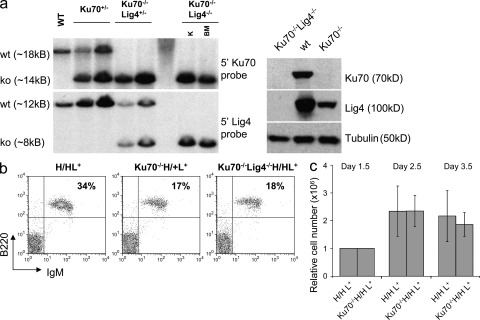Figure 1.
Ku70−/−HL and Ku70−/−Lig4−/−HL mice posses mature splenic B cells which proliferate in response to stimulation by αCD40/IL-4. (a) Disruption of the Ku70 and Lig4 genomic loci and absence of Ku70 and Lig4 proteins in Ku70−/−Lig4−/− mice. (left) Southern blotting: BamHI-digested genomic DNA was probed with Ku70- or Lig4-specific probes. (right) Thymus protein extracts were assayed for the presence of Ku70 or Lig4 proteins. K, kidney protein extracts; BM, bone marrow protein extracts. Both the Southern and the Western blotting were repeated two times on independent samples. (b) WT-HL, Ku70−/−HL and Ku70−/−Lig4−/−HL mice have mature splenic B cells. Whole cell suspensions from spleens of WT-HL, Ku70−/−HL, and Ku70−/−Lig4−/−HL were used to quantify the percentage of B220+IgM+ mature B cells. Data shown are representative of more than 10 experiments, with at least one mouse of each genotype per experiment. (c) Ku70−/−HL mature B cells proliferate at levels comparable to WT-HL after αCD40/IL-4 stimulation. Splenic B cells were enriched with B220 magnetic beads and counted by Trypan blue staining starting at day 1.5 from the beginning of the culture, to allow for the disappearance of non–B cells. Data shown are based on two independent stimulations and a total of 4 WT-HL and 5 Ku70−/−HL mice were used. Error bars are based on the relative cell number for each mouse.

